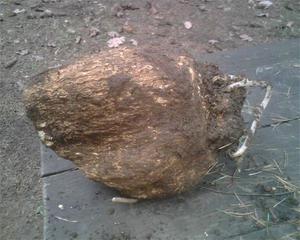
Pinyin: Fu Ling Latin: Poria Cocos
Physical Characteristics*
Poria cocos (Chinese Pinyin: Fu Ling) is a sweet, bland and neutral herb. This medicinal fungus has been widely used and highly respected in Asia. In the wild, Poria cocos grows much like the European truffle, only it grows around the roots of certain pine trees instead of oaks. In traditional Chinese medicine, it is claimed to soothe the heart, disperse moisture and stagnation, strengthen vital energy, and assuage agitation; treat abdominal distension, edema, difficult urination, diabetes and diarrhea; enhance, protect, and restore liver function; modulate the immune system, balance blood sugar, and boost fat metabolism; have a whitening effect of skin, and reduce the appearance of pores and blackheads.*
Traditional Chinese Medicinal (TCM) Uses*
In TCM, Fu ling has been used for edema, improving liver and kidney functions, strengthen the spleen, calm the spirit, removal of obstructive phlegm and help with insomnia.1 Fu ling has also been used to support the following: improve body weight, improve appetite, lessen or prevent side effect of chemo therapy, protect bone marrow, improve radiation therapy on nose and throat cancers, diarrhea, improve schizoid condition, for baldness, as diuretics, in urinary difficulty, edema, water retention, pixu with water retention. Urination difficulty due to damp heat. Pixu with mucus production and headache, dizziness, palpitations, with think greasy tongue coating. Palpitation, insomnia or forgetfulness, loss of appetite. Inflammation of the uterus and chronic sinusitis, diuretics, reducing plasma glucose, tranquilizing, inhibits bacteria, relaxing effect on smooth muscles, improves immune system.2*
References
Natural dietary supplements are designed to offer the body support to promote health, harmony, balance and overall well being.*

 Get Well Natural, LLC
Get Well Natural, LLC  Kidney Function & Regeneration Health
Kidney Function & Regeneration Health  Platelet & Blood Cell Health
Platelet & Blood Cell Health  Prostate, Flow & Function Health
Prostate, Flow & Function Health  General Mind & Body Health
General Mind & Body Health  Heart, Cholesterol & Cardio Health
Heart, Cholesterol & Cardio Health  Allergy-Free Body
Allergy-Free Body  Anxiety & Stress
Anxiety & Stress  Blood Platelet Counts & Function
Blood Platelet Counts & Function  Blood Pressure Health
Blood Pressure Health  Kidney Health
Kidney Health  Immune System Health & Balance
Immune System Health & Balance  Prostate & Urinary Health Function
Prostate & Urinary Health Function  Blood Sugar Balance
Blood Sugar Balance  Cardiovascular Heart Health
Cardiovascular Heart Health  Detoxification & Healthy Cells
Detoxification & Healthy Cells  Women's Health
Women's Health  Liver Regeneration
Liver Regeneration  Pain-Free Body
Pain-Free Body  Water & Air Filtration
Water & Air Filtration 


